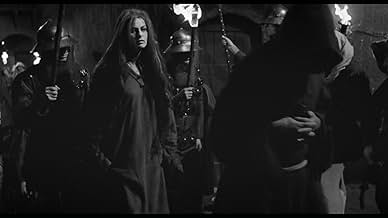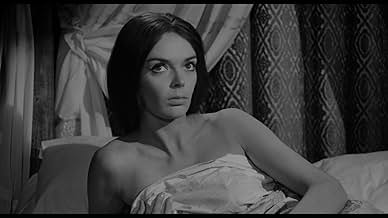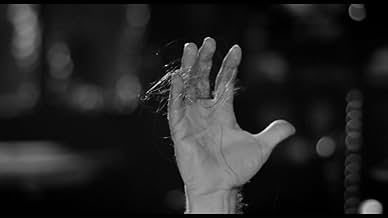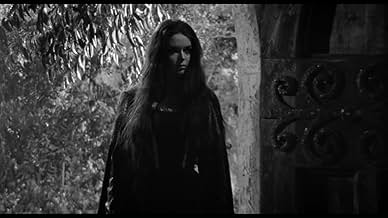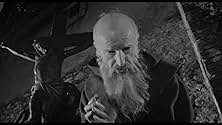IMDb RATING
6.2/10
2K
YOUR RATING
A woman under suspicion of witchcraft is burned alive. Her curse brings her back from the dead for revenge.A woman under suspicion of witchcraft is burned alive. Her curse brings her back from the dead for revenge.A woman under suspicion of witchcraft is burned alive. Her curse brings her back from the dead for revenge.
Umberto Raho
- Von Klage, the Priest
- (as Robert Rains)
Laura Nucci
- Grumalda
- (as Laureen Nuyen)
Giuliano Raffaelli
- Count Humboldt
- (as Jean Rafferty)
Nello Pazzafini
- Monk, the Servant
- (as John Carey)
Aldo Barozzi
- Plague Victim
- (uncredited)
Mario Casella
- Gorca
- (uncredited)
Severino D'Ottavi
- Party Guest
- (uncredited)
Alba Maiolini
- Wife of Plague Victim
- (uncredited)
Aldo Massasso
- The Priest
- (uncredited)
Enzo Mondino
- Villager at the Execution
- (uncredited)
Piero Pastore
- Baron Von Letz
- (uncredited)
Sylvia Sorrente
- Gorca's Wife
- (uncredited)
Terry Velasco
- Gorca's Daughter
- (uncredited)
Featured reviews
After hearing so much about the often ballyhooed Black Sunday film which predates this one I finally got the chance to check out both films for myself. Black Sunday a.k.a the Mask Of Satan is also a Gothic b/w Italian horror film that features Barbara Steele as it's main character. Every review that I came across recommended the Mario Bava movie without any reservations whatsoever and made constant references to it's beautiful cinematography, period detail and atmosphere. I was super anxious to see this unanimously lauded classic. However, once viewed, I did not find the Mask of Satan to be that great of a movie. Yes, it was beautifully filmed and yes it was quite atmospheric but it was also flat, boring and predictable. It's dated violence and special effects did very little to help liven things up. The eerie soundtrack that seemed to constantly be playing was too loud and it actually served to slaughter, in it's infancy, any tension that possibly might have been building. The film felt like a major let down after hearing so much about it. It was o.k. but nearer to a novelty than a classic. The Long Hair Of Death was a film which I had heard absolutely nothing about. I only just learned of it's existence when it was recently scheduled to be released on blu ray in the near future. The cover art was intriguing and there was Barbara Steele again. So I found the movie on YouTube and set out to see if it was worth adding to my collection. Little did I know what a treat I was in for. This movie is similar in look and feel to Bava's film yet it is superior to that film due to it's character development and it's bizarre and intermittent flashes of kinky eroticism. The pacing is glacial in this one also and yet it doesn't feel quite as moribund as "Sunday". The camera work is lovely and lush and is perfectly enhanced by vividly detailed decorative sets and costumes. The acting is better in this one too although the dialog is pretty standard for this type of fare. All in all, I prefer The Long Hair of Death to Black Sunday on any given day and will be purchasing a copy on blu ray ASAP.
Long Hair of Death is a great film. I have to disagree with other reviewers regarding this, both those here on the IMDb and some in printed publications. This is 1960s Italian horror at its very best and, to me, that means it is among the very best, period. I can understand why many in today's impatient, multi-task oriented audience would not like slow moving, atmospheric films which are very dull compared to the current era's action and gore oriented offerings. Films such as these require a cultivated taste of sorts and I realize they are not for everybody.
Long Hair of Death is outstanding because it is exactly what those who do not like it say that it is. It is slow moving, contains little action and there are long periods of -- not much. Not much, except for a feeling of dread and unease that begins immediately after the story begins and does not end until literally the film's end. The slowness is the main reason the viewer sits in uncomfortable agony waiting for something bad to happen, which eventually does.
The story concerns a woman burnt at the stake in 16th century Italy, falsely accused of murder. That she happens to be a count's wife and the count's son the real villain of the story are of great importance in the storyline. Giorgio Ardisson as the evil Kurt Humboldt is one of the big screen's most despicable characters, as throughout the film he commits multiple murder and rape, but sadly most persons not interested in obscure cinema will never know this or experience his splendid performance. The great Barbara Steele (How I wish she had done a greater body of work!) plays a dual role, her characters being pretty much the same as they were in 1960's Black Sunday, (La Maschera del Demonio), as Helen Karnstein, wife of Count Humboldt and also as her daughter Mary. Again, the story is pretty much the same as Black Sunday, with the emphasis being on the executed Helen and the curse she places upon the Count and his son Kurt Humboldt. Daughter Mary, who is a lookalike for her mother, assists in the revenge by playing upon the Count's guilt to destroy him emotionally and getting Kurt to fall in love with her. The fact that Kurt is already married to Mary's sister Elizabeth, herself abused by Kurt, adds dramatically to the sense of moral decay in the Humboldt castle.
The ultimate revenge is as creative as it is brutal. Watch the film to see what it is, I won't provide SPOILERS here.
Barbara Steele remains to this day the standard which all horror (scream) queens are judged, and that is interesting because she does very little screaming and performs little if any violence in her films. She is to horror acting what Alfred Hitchcock was to suspense directing. They frighten you with "What if . . . ," instead of actual brutality and exaggerated acting. From the moment she first appears on screen in any of her films one knows trouble will soon follow and it has nothing to do with anything she says or does. Whatever "it" is, she has it in abundance. Long Hair of Death will remind some viewers of 1972's Lisa and the Devil, (Lisa e il Diavolo) another story of a decaying household but set to modern times. One wonders how much better that film would have been with Ms. Steele in the lead instead of Elke Sommer, a fine actress but out of her depth in psychological horror.
Director Antonio Margheriti has never received the credit he deserves as a fine director of subdued horror. Margheriti will take you on a painstaking walk through the dreariest of castles and make you feel the suspense of every hesitant step and so it is with Long hair of Death. I recently viewed Long Hair of Death after having not seen it in awhile and was emotionally drained by the time the end credits rolled.
If you are unfamiliar with this type of film and are unimpressed with the sensationalism of today's cinema, then find Long Hair of Death or any of the other fine films of Margheriti or Mario Bava. I believe you will be pleasantly surprised and join me in my admiration of Italian horror cinema of this period.
Long Hair of Death is outstanding because it is exactly what those who do not like it say that it is. It is slow moving, contains little action and there are long periods of -- not much. Not much, except for a feeling of dread and unease that begins immediately after the story begins and does not end until literally the film's end. The slowness is the main reason the viewer sits in uncomfortable agony waiting for something bad to happen, which eventually does.
The story concerns a woman burnt at the stake in 16th century Italy, falsely accused of murder. That she happens to be a count's wife and the count's son the real villain of the story are of great importance in the storyline. Giorgio Ardisson as the evil Kurt Humboldt is one of the big screen's most despicable characters, as throughout the film he commits multiple murder and rape, but sadly most persons not interested in obscure cinema will never know this or experience his splendid performance. The great Barbara Steele (How I wish she had done a greater body of work!) plays a dual role, her characters being pretty much the same as they were in 1960's Black Sunday, (La Maschera del Demonio), as Helen Karnstein, wife of Count Humboldt and also as her daughter Mary. Again, the story is pretty much the same as Black Sunday, with the emphasis being on the executed Helen and the curse she places upon the Count and his son Kurt Humboldt. Daughter Mary, who is a lookalike for her mother, assists in the revenge by playing upon the Count's guilt to destroy him emotionally and getting Kurt to fall in love with her. The fact that Kurt is already married to Mary's sister Elizabeth, herself abused by Kurt, adds dramatically to the sense of moral decay in the Humboldt castle.
The ultimate revenge is as creative as it is brutal. Watch the film to see what it is, I won't provide SPOILERS here.
Barbara Steele remains to this day the standard which all horror (scream) queens are judged, and that is interesting because she does very little screaming and performs little if any violence in her films. She is to horror acting what Alfred Hitchcock was to suspense directing. They frighten you with "What if . . . ," instead of actual brutality and exaggerated acting. From the moment she first appears on screen in any of her films one knows trouble will soon follow and it has nothing to do with anything she says or does. Whatever "it" is, she has it in abundance. Long Hair of Death will remind some viewers of 1972's Lisa and the Devil, (Lisa e il Diavolo) another story of a decaying household but set to modern times. One wonders how much better that film would have been with Ms. Steele in the lead instead of Elke Sommer, a fine actress but out of her depth in psychological horror.
Director Antonio Margheriti has never received the credit he deserves as a fine director of subdued horror. Margheriti will take you on a painstaking walk through the dreariest of castles and make you feel the suspense of every hesitant step and so it is with Long hair of Death. I recently viewed Long Hair of Death after having not seen it in awhile and was emotionally drained by the time the end credits rolled.
If you are unfamiliar with this type of film and are unimpressed with the sensationalism of today's cinema, then find Long Hair of Death or any of the other fine films of Margheriti or Mario Bava. I believe you will be pleasantly surprised and join me in my admiration of Italian horror cinema of this period.
Well, it's obvious that The Long Hair of Death takes a lot of its influence from the Mario Bava masterpiece 'Black Sunday', but even so; Antonio Margheriti's film manages to deliver a good horror story in its own right. The plot is pretty much your classic Gothic horror yarn, and focuses on a small village. A woman is accused of being a witch and promptly put to death. However, her eldest daughter knows the real reason for her death revolves around the lord, and she's promptly killed also. The youngest daughter survives and is taken in by the murderous lord's family, eventually marrying his son. Soon after, a deadly plague threatens the village; and the older daughter reappears to avenge her mother's death. The main standout of this movie is definitely the atmosphere - director Antonio Margheriti does an excellent job of giving the movie a foreboding feel through the eerie black and white cinematography and the imposing sets. The plot can drag a bit at times, which is a shame; and so it's lucky that Margheriti was able to give the film an atmosphere as it keeps it going when the plot takes a downturn.
Another standout about this film is, of course, the fact that it has a leading role for Barbara Steele. Of course, she was almost certainly cast because of her success in Black Sunday, and as such; this isn't her greatest performance, but she's always nice to see and she does play the resurrected woman well. It does quite often seem like Margheriti is dragging the plot out and this is a shame as the film is overlong as a result and it has to be said that The Long Hair of Death would have benefited from a shorter running time. Antonio Margheriti made some good films in his career, though the fact that he doesn't get good recognition along with the likes of Sergio Martino and Lucio Fulci doesn't surprise me. This film was released in between Margheriti's successes with The Virgin of Nuremberg and Dance Macabre, and although I prefer both of the mentioned films; this one is still worth seeing for the Italian Gothic horror fan. The film boils down to a somewhat predictable ending, but it's a nice ride getting there and overall, despite the fact that The Long Hair of Death may not be the most successful film of it's type - it's still worth a watch.
Another standout about this film is, of course, the fact that it has a leading role for Barbara Steele. Of course, she was almost certainly cast because of her success in Black Sunday, and as such; this isn't her greatest performance, but she's always nice to see and she does play the resurrected woman well. It does quite often seem like Margheriti is dragging the plot out and this is a shame as the film is overlong as a result and it has to be said that The Long Hair of Death would have benefited from a shorter running time. Antonio Margheriti made some good films in his career, though the fact that he doesn't get good recognition along with the likes of Sergio Martino and Lucio Fulci doesn't surprise me. This film was released in between Margheriti's successes with The Virgin of Nuremberg and Dance Macabre, and although I prefer both of the mentioned films; this one is still worth seeing for the Italian Gothic horror fan. The film boils down to a somewhat predictable ending, but it's a nice ride getting there and overall, despite the fact that The Long Hair of Death may not be the most successful film of it's type - it's still worth a watch.
I think this is one of Barbara Steele's better horror films. It does have a creepy Gothic atmosphere - and great Gothic music to go with it. I like quite a few of the Italian horror films from the 1960s - 1970s - this is one of them.
This film surrounds a witch and lust. A woman with two daughters is taunted by a man who lusts for her - so much so he would force her into making love to him. She refuses him and is accused of witchcraft and therefor put to death. The older daughter is later put to death and leaving the youngest daughter alive. She grows up and marries... later on the older daughter (apparently a witch) comes back from the dead to seek revenge on those who harmed her family.
Good late night flick!!
7/10
This film surrounds a witch and lust. A woman with two daughters is taunted by a man who lusts for her - so much so he would force her into making love to him. She refuses him and is accused of witchcraft and therefor put to death. The older daughter is later put to death and leaving the youngest daughter alive. She grows up and marries... later on the older daughter (apparently a witch) comes back from the dead to seek revenge on those who harmed her family.
Good late night flick!!
7/10
The great Antonio Margheriti, Italy's second-greatest Gothic Horror director (right after the unmatched Mario Bava), and the wonderful Barbara Steele, Horror's single greatest leading lady ever made two magnificent films in 1964. One was the insanely brilliant "Danza Macabra" (aka. "Castle of Blood"), which doubtlessly ranks among the greatest Gothic Horror films ever to be made. The other is this atmospheres and wonderfully macabre gem called "I Lunghi Capelli Della Morte" aka. "The Long Hair of Death". Maybe not quite as essential a masterpiece as "Danza Macabra", "The Long Hair of Death" is yet another glorious film by Margheriti, which once again proves that Barbara Steele is the ultimate goddess of Horror.
The film is magnificently set in the 15th century, when accused witch Adele Karnstein is burned in a rather bizarre stake ritual. While she is being lead to the stake, her oldest daughter Helen Karnstein (Barbara Steele)is forced into sex with the Count whom she has begged to set her mother free. Just before being consumed by the flames, however, the condemned witch puts a curse on the responsible Count and his ruthless son, vowing to take revenge from beyond her burning grave...
This is only a very vague description of the first ten minutes of the film, but since I would hate to spoil any of this gem's wonderful spooks, I will leave it there. The storyline is fascinating and truly macabre, and includes trademark Gothic elements such as curses, resurrection and revenge as well as the black plague. As in all Gothic Horror films by Margheriti, the atmosphere is incredibly eerie and haunting, yet beautiful at the same time. Gloomy castle corridors and dark tombs make an excellent setting for this film's wonderfully creepy storyline. Barbara Steele is, as always, brilliant and absolutely wonderful. As always when reviewing a film with my favorite actress, I get the feeling of not finding the right words, since I simply cannot praise this wonderful actress enough. The other performances are good too, especially Halina Zalewska, who plays the second female lead, is worth mentioning. It's also fun to see a small supporting performance by Italian Cult-cinema regular Nello Pazzafini. Pazzafini's name isn't very well-known, but he was omnipresent in Italian films of many genres in the 60s and 70s, mostly in Spaghetti Westerns, Gialli and Poliziotteschi. This is one of the earlier films I've seen him in. It is, of course, Barbara Steele who is the main attraction, however. As said above, the atmosphere is wonderfully eerie and the settings are great. The film is beautifully shot, even though my copy isn't in the best quality. The score is also very cool and contributes a lot to the film's haunting mood. For all the horny Horror fans out there, an additional quality of this film should be revealed: In one love-making scene Barbara Steele's left breast is revealed! (I am not sure, however, whether it belongs to Barbara Steele or a body double). All things considered, this is yet another great Gothic Horror gem with the genre's undisputed goddess, Barbara Steele, and no Horror/Cult-cinema lover should consider missing it. 8.5/10
The film is magnificently set in the 15th century, when accused witch Adele Karnstein is burned in a rather bizarre stake ritual. While she is being lead to the stake, her oldest daughter Helen Karnstein (Barbara Steele)is forced into sex with the Count whom she has begged to set her mother free. Just before being consumed by the flames, however, the condemned witch puts a curse on the responsible Count and his ruthless son, vowing to take revenge from beyond her burning grave...
This is only a very vague description of the first ten minutes of the film, but since I would hate to spoil any of this gem's wonderful spooks, I will leave it there. The storyline is fascinating and truly macabre, and includes trademark Gothic elements such as curses, resurrection and revenge as well as the black plague. As in all Gothic Horror films by Margheriti, the atmosphere is incredibly eerie and haunting, yet beautiful at the same time. Gloomy castle corridors and dark tombs make an excellent setting for this film's wonderfully creepy storyline. Barbara Steele is, as always, brilliant and absolutely wonderful. As always when reviewing a film with my favorite actress, I get the feeling of not finding the right words, since I simply cannot praise this wonderful actress enough. The other performances are good too, especially Halina Zalewska, who plays the second female lead, is worth mentioning. It's also fun to see a small supporting performance by Italian Cult-cinema regular Nello Pazzafini. Pazzafini's name isn't very well-known, but he was omnipresent in Italian films of many genres in the 60s and 70s, mostly in Spaghetti Westerns, Gialli and Poliziotteschi. This is one of the earlier films I've seen him in. It is, of course, Barbara Steele who is the main attraction, however. As said above, the atmosphere is wonderfully eerie and the settings are great. The film is beautifully shot, even though my copy isn't in the best quality. The score is also very cool and contributes a lot to the film's haunting mood. For all the horny Horror fans out there, an additional quality of this film should be revealed: In one love-making scene Barbara Steele's left breast is revealed! (I am not sure, however, whether it belongs to Barbara Steele or a body double). All things considered, this is yet another great Gothic Horror gem with the genre's undisputed goddess, Barbara Steele, and no Horror/Cult-cinema lover should consider missing it. 8.5/10
Did you know
- GoofsObvious doll is used to replace the actress at the start of the movie in the burning scene.
- ConnectionsFeatured in Moviedrome: Long Hair of Death (I Lunghi Capelli Della Morte) (1988)
- How long is The Long Hair of Death?Powered by Alexa
Details
- Release date
- Country of origin
- Language
- Also known as
- Los largos cabellos de la muerte
- Filming locations
- Production company
- See more company credits at IMDbPro
- Runtime
- 1h 36m(96 min)
- Color
- Aspect ratio
- 1.85 : 1
Contribute to this page
Suggest an edit or add missing content

